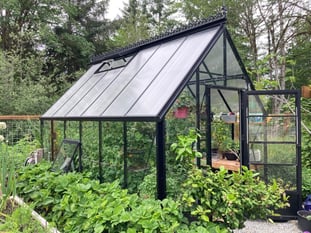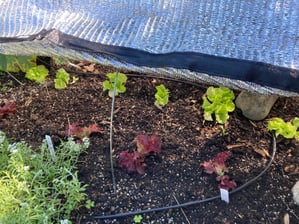Quick Answer:
What are the best tips for a successful late summer greenhouse harvest? As the season transitions, focus on four essential strategies: switch to a low-nitrogen fertilizer (like a 2-8-4 mix with kelp and micronutrients) to build plant strength without promoting excessive growth; maintain strong air circulation with fans to prevent fungal issues as nights cool; start fresh crops like lettuce and arugula to extend your harvest into fall; and apply targeted shading using aluminet or shade cloth to protect plants from intense late-summer sun. These greenhouse gardening tips will help you maximize yields and enjoy a longer, more productive harvest season.
 Late Summer Gardening Tips
Late Summer Gardening Tips
It is late August and I am chatting with my daughter who lives in Northern Alberta, Canada. Her outside garden has never looked so good because of the heat and regular rains. But she is wishing she could get another month on either end of the growing season.
My daughter's dream is easily solved with a greenhouse. Even though she is living in the north, she can plant in April instead of late May once she gets her greenhouse. And instead of harvesting tomatoes in a hurry in late August or early September, she can harvest them at her leisure in later September and into October.
This is not the only or highest use of a greenhouse for greenhouse gardening but if you are getting that extra month of spring and summer from your greenhouse it sure boosts your harvest. Meanwhile, here are four tips to make this the best month yet in your greenhouse!

Fertilize Carefully:
 It is too late to "push" lush growth come September 1 so, instead of using your regular summer fertilizer with high nitrogen, use fertilizer packed with micronutrients and a very low amount of nitrogen. To see how much nitrogen your fertilizer has, look at the first number on the fertilizer label. If you have been using 20-20-20 it has 20% nitrogen. Switching to 2-8-4 means you are only adding 2% nitrogen.
It is too late to "push" lush growth come September 1 so, instead of using your regular summer fertilizer with high nitrogen, use fertilizer packed with micronutrients and a very low amount of nitrogen. To see how much nitrogen your fertilizer has, look at the first number on the fertilizer label. If you have been using 20-20-20 it has 20% nitrogen. Switching to 2-8-4 means you are only adding 2% nitrogen.
The numbers on fertilizer packages vary greatly but if nitrogen is too high late in the season it will stimulate new growth and lots of green leaves. Read the fine print. on products at your garden centers because that is probably the only way you will find a low-nitrogen fertilizer today. Look for a fertilizer with the added benefits of Kelp and micronutrients as well. The micronutrients such as Magnesium, Iron and Calcium will build plant strength without adding to lush growth and the kelp makes the fertilizer more available to plants. An example of low nitrogen, micronutrient and kelp-containing fertilizer is here.
Keep the Fan On:
Air circulation as the evenings get cooler is very important. Air movement stops moisture from settling on leaves and causing fungus growth when temperatures dip in the late summer. I keep a small Caframo Chinook Fan running in my small 8x12 greenhouse and a larger Horizontal Airflow Fan in my 16x20 greenhouse. This is so important and I almost always forget to mention it but fall is a key time to keep the air moving. If possible, keep the screen doors open on your greenhouse well into fall too.
Start New Plants:

I just started new lettuce and arugula yesterday and some of it has already germinated. I didn't do this because I am work-obsessed but because my family eats salad year-round and we are starting to run low on lettuce. Also, some of the heads have become overgrown and elongated as they overheated this month and they are not as tasty once they get big.
Keep Shading
The conditions are perfect for growing into fall in my greenhouse but when the sun gets lower on the horizon and beats down on the south-facing beds, I reach for shade cloth.

To apply quick shade push lengths of #9 wire into the ground 2 feet (60 cm) apart and clip aluminet shade cloth over the wire. This keeps outdoor crops of lettuce from getting too much light and in the greenhouse, on the south-facing side, aluminet works as a temporary cover on newly planted lettuce to keep it soft and tender longer. The larger shade cloth on your greenhouse will come done by late September but it only covers the top of the greenhouse so the hot spots, such as the south-facing beds, need this bit of extra shade.
More from Donna

For more great tips from Donna, visit www.donnabalzer.com.
You can also read Donna’s gardening books: No Guff Vegetable Gardening with Steven Biggs and keep track of your success with her Gardener’s Gratitude Journal: Part Diary, Part Personal Growing Guide.



